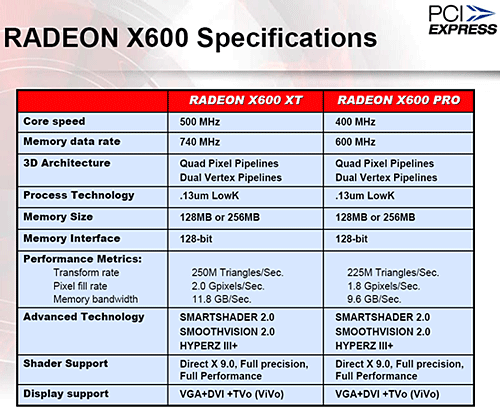ATi PCI Express Sneak Peek
Radeon X600 and X300 - New PCI Express Solutions From ATi


ATi is also announcing their X600 and X300 series of PCI Express based cards targeted at the mid range and value segment of the market. The thing to note here is that basically the core VPU technology on these two families has actually been available from ATi for over a year now, with sightings in the back rooms of various trade shows along the way.
|

 The X600 Pro and X600 XT are based on ATi's RV380 graphics core. Unfortunately, this core is not a derivative of the R4XX architecture but instead it based on ATi's Radeon 9600 RV360 VPU. It has the same number of pixel pipelines and vertex pipelines, the same 128-bit memory bus and is also built on TSMC's .13 micron Low-K process that has worked so well for ATi over the past year or so. Fillrate and memory bandwidth stay the same as well, with the exception of a nice memory bandwidth boost that was afforded to the Radeon X600 XT at 740Mhz, for a total of 11.8GB/sec. Other than that, the card is nearly identical, with the exception of its new PCI Express edge connector and a native PCI Express core driving that physical interface. Also, look Ma, no power connector once again. You've got to love that, if you're a cool and quiet PC type.
The X600 Pro and X600 XT are based on ATi's RV380 graphics core. Unfortunately, this core is not a derivative of the R4XX architecture but instead it based on ATi's Radeon 9600 RV360 VPU. It has the same number of pixel pipelines and vertex pipelines, the same 128-bit memory bus and is also built on TSMC's .13 micron Low-K process that has worked so well for ATi over the past year or so. Fillrate and memory bandwidth stay the same as well, with the exception of a nice memory bandwidth boost that was afforded to the Radeon X600 XT at 740Mhz, for a total of 11.8GB/sec. Other than that, the card is nearly identical, with the exception of its new PCI Express edge connector and a native PCI Express core driving that physical interface. Also, look Ma, no power connector once again. You've got to love that, if you're a cool and quiet PC type.
However, since they introduced the Radeon 9600 series well over a year ago, ATi has had a model of driving leading edge technology in their mainstream desktop graphics offering, rather than pushing it into the high end, as NVIDIA has been known for. This approach certainly has worked well for ATi, since core complexity isn't as high, which can help mitigate the risk of implementing designs in bleeding edge processes. It's seems ATi is taking that path once again, with their new R370 VPU.

 Radeon X300 and X300SE cards are based on a .11 micron Low-K TSMC manufacturing process, which means they're produced using the smallest die geometry in a mainstream graphics core manufacturing process. This again will afford ATi the ability to build these boards with a considerable cost advantage at the VPU level. While this is great from a pricing standpoint for the consumer, we were a little bit disappointed in the core clock and memory speeds on these two models, since smaller die geometries should theoretically offer higher available clock speeds. Regardless, these cards are to be considered in the $79 or less price range, so ATi is driving cost out wherever they can. Lower clock speeds mean higher yield and lower cost, plain and simple. In addition, note the use of standard TSOP packaged DDR DRAM on this card. This is yet another cost control measure, since that package style is what mainstream memory DIMM manufacturers are driving in million pc quantities today.
Radeon X300 and X300SE cards are based on a .11 micron Low-K TSMC manufacturing process, which means they're produced using the smallest die geometry in a mainstream graphics core manufacturing process. This again will afford ATi the ability to build these boards with a considerable cost advantage at the VPU level. While this is great from a pricing standpoint for the consumer, we were a little bit disappointed in the core clock and memory speeds on these two models, since smaller die geometries should theoretically offer higher available clock speeds. Regardless, these cards are to be considered in the $79 or less price range, so ATi is driving cost out wherever they can. Lower clock speeds mean higher yield and lower cost, plain and simple. In addition, note the use of standard TSOP packaged DDR DRAM on this card. This is yet another cost control measure, since that package style is what mainstream memory DIMM manufacturers are driving in million pc quantities today.

We'll close with a quick glance at ATi's new family of PCI Express based cards, their speeds, feeds, associated fill rates and memory bandwidth.

As you'll note here, this is fairly well rounded product offering that we expect ATi will flesh out a bit more in the months ahead. While we have 16 and 12 pipe VPUs in the top end, we're hopeful that another 12 pipe or even 8 pipe R4XX variant may come to market sometime soon. While we haven't heard any gyrations from ATi on this, one could speculate a bit here. Stay tuned in the weeks ahead, as next generation PCI Express based chipsets for the Pentium 4 are launched. We'll have graphics performance coverage included in those stories and you'll be able to see a couple of these cards in action as well.






